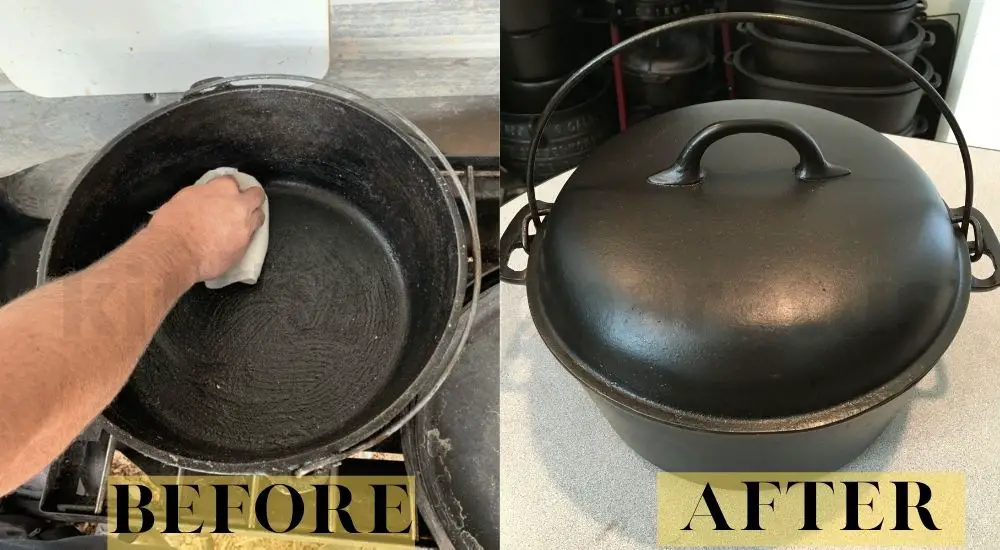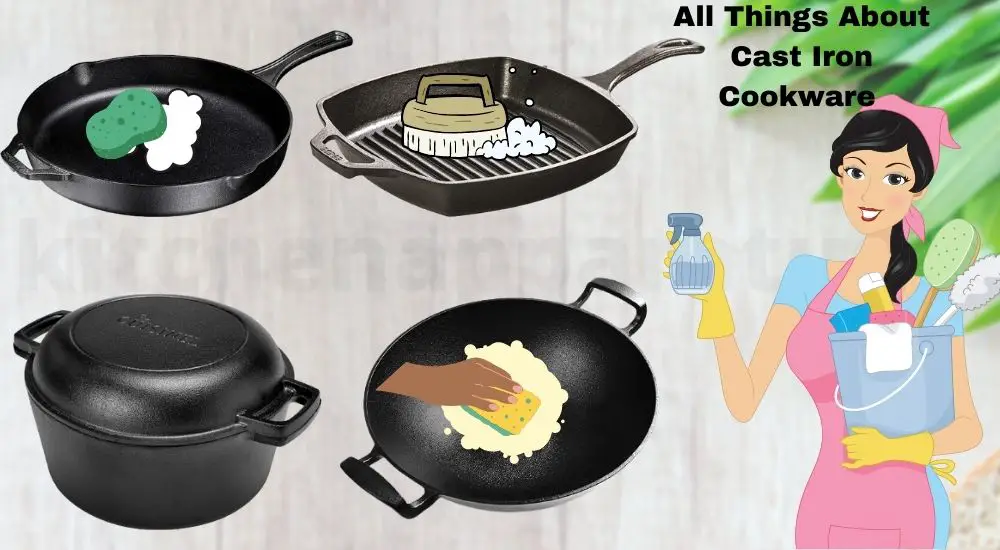
Cast iron cookware is a fan-favorite, and cleaning cast iron is like the highest form of opinion; everybody likes to claim they have one. Some people prefer not letting their cast iron frypan near water, forget detergent, while others will do all it takes even if it means breaking a few traditional rules.
Today we look at all the ways we can deal with our cast iron misadventures in one go!
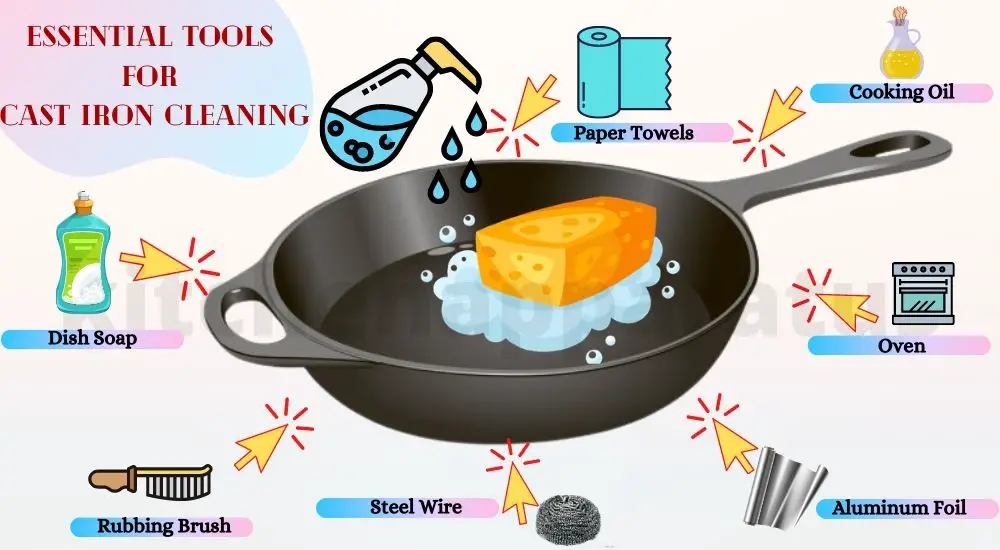
Reincarnation Episode One: Your Rusty Cast Iron Skillet & Griddle
First off, you’re going to need the right tools to deal with the mess head-on. Gather around a steel wire, some dish soap, a scrubbing brush, paper towels, cooking oil of your preference, aluminum foil, and an oven.
Now for the instructions, prepare yourself, maybe make a cup of lemon tea (you’re going to need the afternoon), and breathe.
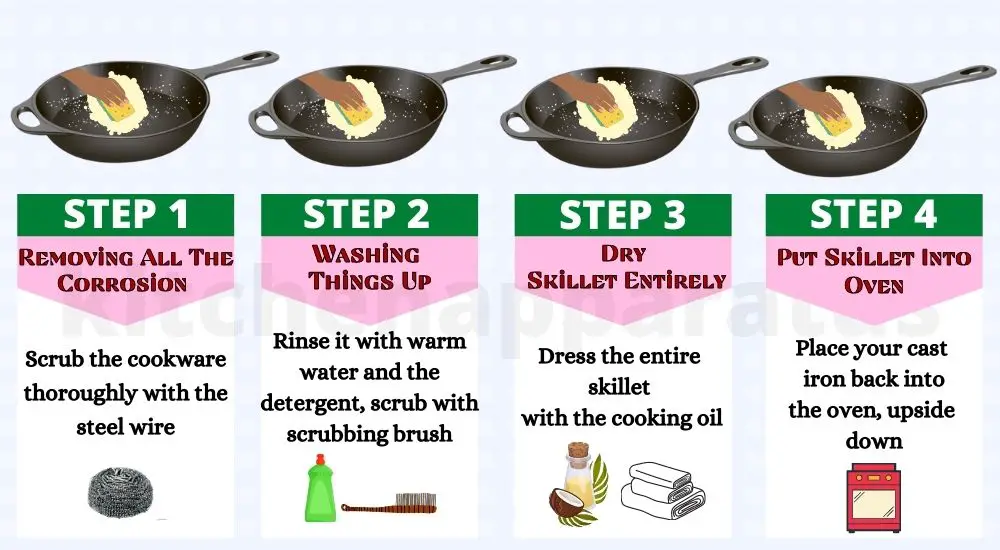
Your First Step
Involves removing all the corrosion; this is where the steel wire comes to use. Scrub the cookware thoroughly with the steel wire, especially the affected rusty regions. Continue the process until your cast iron returns to its natural raw look.
The Second Step
Is all about washing things up; take your cast iron cookware and rinse it with warm water and the detergent you have, use the scrubbing brush to gently scrub away as well.
Almost There
Then, dry your skillet entirely immediately after the wash using the clean paper towels. Now, dress the entire skillet with the cooking oil at your service. When we say ‘entire’ we mean the base of the skillet and the handles as well, so do not miss a spot. But only use a minimal amount so as not to make the skillet a sticky mess.
For The Final Part
Place your cast iron skillet dressed in cooking oil upside down in the oven. Make sure the skillet sits on the top rack because the bottom rack will need a sheet of aluminum foil on top to recover any oil-spills. Finally, set your oven to heat at 350 degrees Fahrenheit for an hour. Sit down, relax, and sip on your lemon tea, maybe read the health section of your daily newspaper as you wait. When the oven bell dings, turn the heat off, take your skillet out, and embrace it with love. Let it cool down completely and pat yourself on the back because you now have a clean cast iron skillet.
Part 1, Exhibit B: Cleaning The Cast Iron Griddle
The crisp smell of bacon being fried on your griddle is the ideal start to a beautiful morning. However, that’s only possible with consistent maintenance of your griddle, especially if it is cast iron. Hanging it uncovered on the kitchen rack can cause it to rust, lose its heat distribution abilities, and give you boring breakfasts that don’t motivate the morning person in you to awaken.
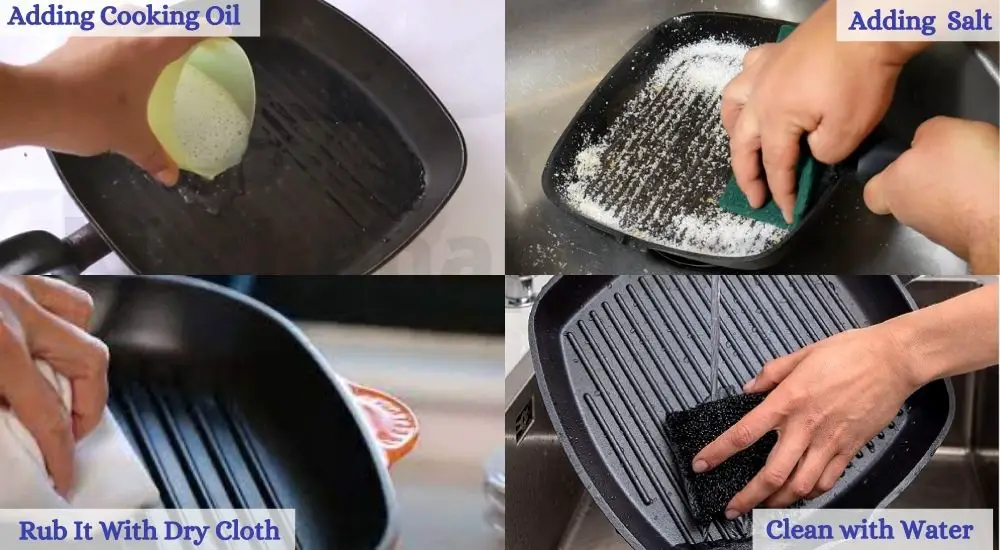
It is equally essential to season the cooking surface of your cast iron. Hence experts go for kosher salt over detergent (the latter can be counterproductive) to both season and clean their iron cookware. It is the granularity of kosher salt that offers an abrasive solution to cleaning your griddle pan of stubborn grease.
Here’s How:
One: If your griddle is hot, allow it to cool down to the touch, but not entirely. Liberally sprinkle the kosher salt all over the cooking surface.
Two: Pour a conservative amount of hot water onto the surface to allow the salt to group together in a paste-like texture. Now the scrub the salt thoroughly covering all the nooks and corners of the griddle with a scrubbing pad.
And Three: Lastly, wash the cast iron griddle with hot water to ensure all salt and grease are removed. Repeat the procedure as necessary.
Part 2: Seasoning
For this part, you’ll need mild dish soap, a soft sponge, paper towels, vegetable oil, and a sheet of aluminum foil.
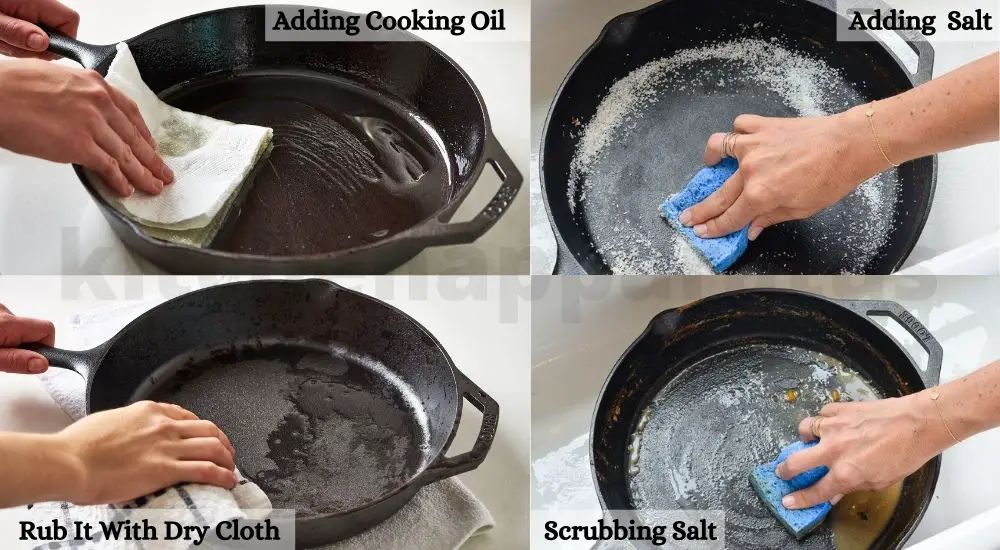
Let’s begin,
Before you wash your skillet, preheat the oven to 350 degrees Fahrenheit. Arrange a warm and soapy water mix and dip your skillet in. Use the soft sponge to scrub away attentively. But it’s important to remember we don’t usually wash our cast iron with soap unless it’s about to be seasoned. Give the skillet a final wash before you dry it off.
Now add a tablespoon or two of vegetable oil (or any cooking oil of your preference), but not anymore. Use the paper towels to smudge the oil around and ensuring it covers the entirety of the body. Do the same as you did when cleaning the rusty skillet and apply the oil on the skillet’s base and sides. Place the skillet inside the oven on the top rack and bake it up for an hour. After the bell dings, let it cool off, and you are now ready to rock with your clean and seasoned cast iron skillet. Your skillet should now feel smooth, clean, glossy, and nonstick.
You Might Like to Read –
Reincarnation Episode Two: Your Cast Iron Dutch Oven & Wok
A dutch oven is always present on a bridal registry or in a kitchen. It is absolutely essential for cold seasons because of all the warm soups, stews, and curries you will be cooking. A cast iron dutch oven is one of the major categories in cookware. Their ability to retain heat and cook at low temperatures for long periods make them crucial. But cast iron can rust, especially if left in cool and unprotected places. Their size makes cleaning the mess more difficult. We bring a salty solution to your cast iron mess.
Part 1, Exhibit A: Cleaning Your Cast Iron Dutch Oven
The Intro:
Grab a large pot (big enough to fit the stockpot comfortably) and fill it with water. Mix in soft detergent and heat the mixture to a boil. Afterward, soak the cast iron dutch oven in the solution and leave it overnight.
The Climax:
The next morning, the grease will have loosened up. Use a soft sponge to scrub the stubborn grease away and wash the dutch oven with clean water. Let the dutch oven dry at room temperature.
The Resolution:
For the final part, take a pack of kosher salt and sprinkle it away liberally. Use a scrubbing pad to thoroughly rub the salt over the greasy and rusty regions. Add more salt and scrub away with patience to make sure all stains have left the dutch oven. Using a paper towel to carefully wipe away the salt and remaining mess.
Part 1, Exhibit B: Cleaning Your Cast Iron Wok
Maybe with time, we change our preferences. Maybe using soap or detergent to clean our cast iron cookware is the way to go. A cast iron wok is light enough and built hard enough to pass the test with flying colors.
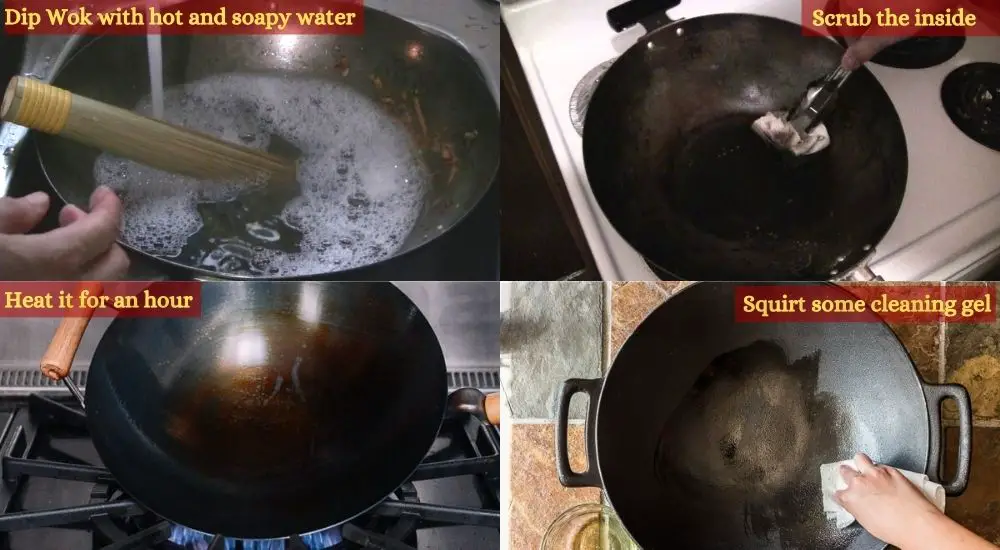 For this, you will need dish soap or detergent (avoid harsh cleaning agents), a scouring pad, water, an oven or stove, and some paper towels.
For this, you will need dish soap or detergent (avoid harsh cleaning agents), a scouring pad, water, an oven or stove, and some paper towels.
Simply fill up your sink with hot and soapy water and dip the wok inside.
Using a scouring pad, scrub the insides and outsides intently and precisely till you can look at the grease loosen up and fall off.
Clean the wok with a separate source of clean water. Afterward, for extra vigilance, squirt some cleaning gel onto the dry wok and add a small amount of water to create a foamy mix. Use the scouring pad (clean it first) and scrub the wok for the final time.
Wash it and heat it for an hour on your stove or oven on high heat. This vigorous process will bring the best out of your greasy cast iron wok. A proper cleaning utilizes the best performances you can get out of any cast iron cookware.
Part 2: Seasoning
Part two is elementary to ensuring all the cleaning doesn’t go down the drain (literally). It involves bone-drying your cast iron. Dryness is the lifeline of any cast iron cookware. Therefore, after washing, heat the cookware in the oven or a stove at 350-450 degrees Fahrenheit. Dress your griddle with vegetable oil using paper towels making sure it reaches the entire body. Afterward, use a soft cloth or another paper towel and rub off any excess oil and let the griddle sit in the oven for an hour. Lastly, allow it to cool completely in the oven.
Bonus Round: Tips to Care for Your Cast Iron Cookware
The best tip you will possibly receive regarding the care of your cast iron is a cleaning regimen. Don’t get lazy (it’s not that tiresome cleaning cast iron anyway) and get to building a cleaning habit.
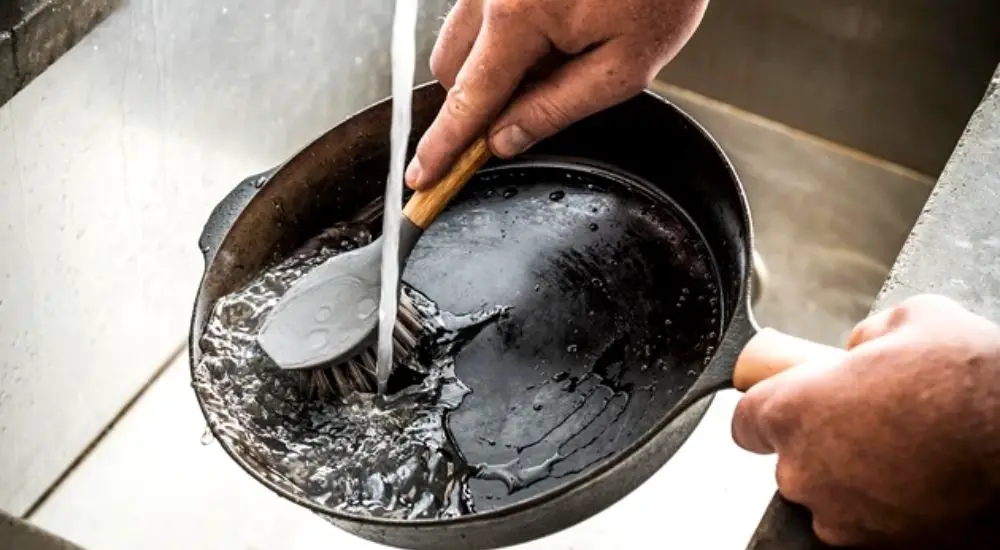
After every use of cast iron griddle, dutch oven, or frypan, wash them. How? Just get hold of a scrubbing brush and some hot water. Scrub them all around while they soak in hot water, and you can add a bit of cleaning detergent if you wish for faster results.
Secondly, always season your cast iron cookware with cooking oil at least once every two weeks. Cast iron rusts the quickest in moist and cool places. And to be frank, the best way to take care of your cast iron cookware is to cook in it every day! Yes, the more you cook, the more oil it touches, and the seasoning remains fresh. Therefore, worry less and cook more with cast iron because they are truly a gift to any kitchen.

